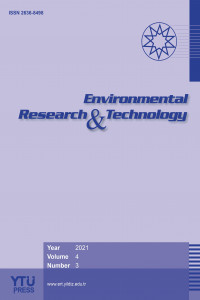Abstract
References
- [1]. Yu, X., Yan, Y., Wang, W. The distribution and bioavailability of heavy metals in different particle size fractions of sediments from the Pearl River estuary and Daya bay South China.Mar Pollut Bull 60:1364-1371. 2010.
- [2]. Connel, D.W. and Miller, G.J. Chemistry and ecotoxicology of pollution (pp.444). New York:Wiley. 1984.
- [3]. Beutel, M.W., Leonard, T.M., Dent, S.R. and Moore, B.C. Effects of aerobic and anaerobic conditions on P, N, Fe, Mn, and Hg accumulation in waters overlaying profundal sediments of an oligo-mesotrophic lake. Water Res. 42, 1953-1962. 2008.
- [4]. Gantzer, P.A.,Bryant, L.D., Little, J.C. Controlling soluble iron and manganese in a water-supply reservoir using hypolimnetic oxygenation. Water Res. 43, 1285-1294. 2009.
- [5]. Davison, W. Iron and manganese in lakes. Earth-Sci. Rev. 34, 119e163. 1993.
- [6]. Munger,Z.W.,Carey ,C.C., Gerling ,A.B. Effectiveness of hypolimnetic oxygenation for preventing accumulation of Fe and Mn in a drinking water reservoir, Water Research,106 ,1-14. 2016.
- [7]. Bryant, L.D.,Hsu-Kim, H., Gantzer, P.A., Little, J.C..Solving the problem at the source: controlling Mn release at the sediment-water interface via hypolimnetic oxygenation., Water Res. 45, 6381-6392. 2011.
- [8]. Kawashima, M., Takamatsu, T., Koyama, M. Mechanisms of precipitation of manganese (II) in Lake Biwa, a fresh water lake. Water Res. 22, 613e618. 1988.
- [9]. Zaw, M.,Chiswell, B. Iron and manganese dynamics in lake water. ,Water Res. 33, 1900-1910. 1999.
- [10]. Liu, J. L., Fan, Y. G., Yang, Z. S., Wang, Z. Y., & Guo, C. Iron and Alzheimer's Disease: From Pathogenesis to Therapeutic Implications. Frontiers in neuroscience, 12, 632. https://doi.org/10.3389/fnins.2018.00632. 2018.
- [11]. Guilarte, T.R. Manganese and Parkinson’s Disease: A Critical Review and New Findings. Environmental Health Perspectives, 118, 8, 1071- 1080. https://doi.org/10.1289/ehp.0901748. 2010.
An experimental study on release mechanism of iron and manganese from sediments to the water column in reservoirs
Abstract
Keywords
Iron Manganese Stratification Aeration Water quality Laboratory study Hypolimnetic oxygenation
References
- [1]. Yu, X., Yan, Y., Wang, W. The distribution and bioavailability of heavy metals in different particle size fractions of sediments from the Pearl River estuary and Daya bay South China.Mar Pollut Bull 60:1364-1371. 2010.
- [2]. Connel, D.W. and Miller, G.J. Chemistry and ecotoxicology of pollution (pp.444). New York:Wiley. 1984.
- [3]. Beutel, M.W., Leonard, T.M., Dent, S.R. and Moore, B.C. Effects of aerobic and anaerobic conditions on P, N, Fe, Mn, and Hg accumulation in waters overlaying profundal sediments of an oligo-mesotrophic lake. Water Res. 42, 1953-1962. 2008.
- [4]. Gantzer, P.A.,Bryant, L.D., Little, J.C. Controlling soluble iron and manganese in a water-supply reservoir using hypolimnetic oxygenation. Water Res. 43, 1285-1294. 2009.
- [5]. Davison, W. Iron and manganese in lakes. Earth-Sci. Rev. 34, 119e163. 1993.
- [6]. Munger,Z.W.,Carey ,C.C., Gerling ,A.B. Effectiveness of hypolimnetic oxygenation for preventing accumulation of Fe and Mn in a drinking water reservoir, Water Research,106 ,1-14. 2016.
- [7]. Bryant, L.D.,Hsu-Kim, H., Gantzer, P.A., Little, J.C..Solving the problem at the source: controlling Mn release at the sediment-water interface via hypolimnetic oxygenation., Water Res. 45, 6381-6392. 2011.
- [8]. Kawashima, M., Takamatsu, T., Koyama, M. Mechanisms of precipitation of manganese (II) in Lake Biwa, a fresh water lake. Water Res. 22, 613e618. 1988.
- [9]. Zaw, M.,Chiswell, B. Iron and manganese dynamics in lake water. ,Water Res. 33, 1900-1910. 1999.
- [10]. Liu, J. L., Fan, Y. G., Yang, Z. S., Wang, Z. Y., & Guo, C. Iron and Alzheimer's Disease: From Pathogenesis to Therapeutic Implications. Frontiers in neuroscience, 12, 632. https://doi.org/10.3389/fnins.2018.00632. 2018.
- [11]. Guilarte, T.R. Manganese and Parkinson’s Disease: A Critical Review and New Findings. Environmental Health Perspectives, 118, 8, 1071- 1080. https://doi.org/10.1289/ehp.0901748. 2010.
Details
| Primary Language | English |
|---|---|
| Subjects | Water Resources and Water Structures |
| Journal Section | Research Articles |
| Authors | |
| Publication Date | September 30, 2021 |
| Submission Date | November 30, 2020 |
| Acceptance Date | September 2, 2021 |
| Published in Issue | Year 2021 Volume: 4 Issue: 3 |


